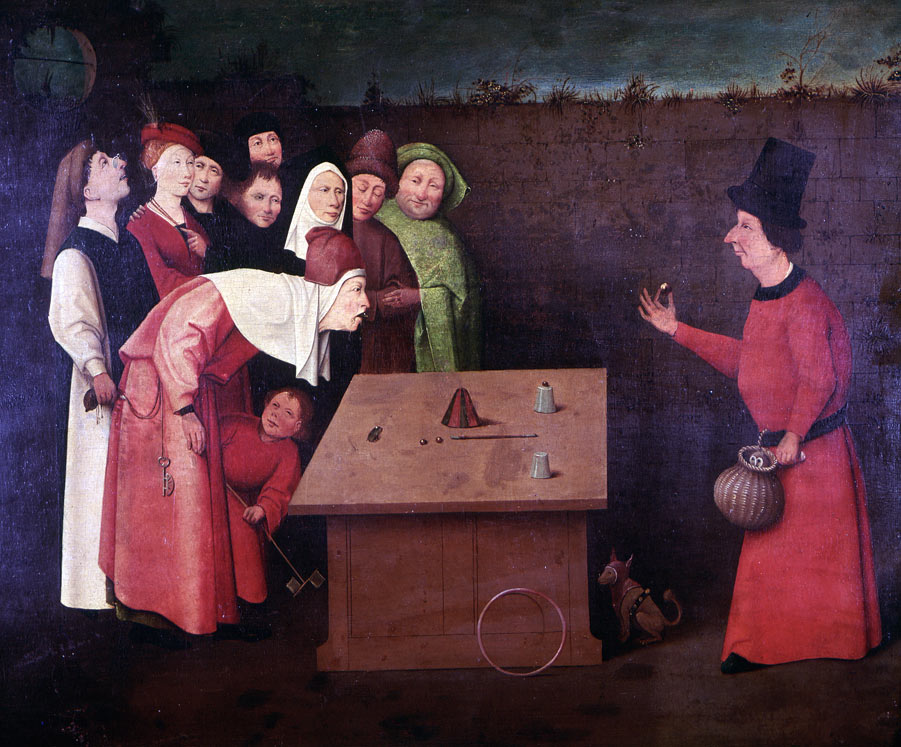The Conjurer, by Heironymus Bosch, depicts a medieval magician performing for a small crowd, while pickpockets steal the spectators' belongings. The painting, on display at the Musée Municipal in St.-Germain-en-Laye, France, illustrates that magicians have long known how to hack into our mental processes. The principles of magic, refined and perfected over the centuries, provide neuroscientists with new ways to study the brain and could help them in their quest to reveal how the organ performs the greatest trick of all - consciousness itself.
"In principle, neuroscience and magic have little in common," says Susana Martinez-Conde, director of the Visual Neuroscience Laboratory at the Barrow Neurological Institute in Phoenix, Arizona. "In fact, they are hugely complementary and magicians have a lot to offer us. They can manipulate the attention and consciousness of spectators so much better than we do in the lab." A few years ago, Martinez-Conde and her husband Stephen Macknik decided to investigate exactly how magicians fool the brain so adeptly. In doing so, they founded the exciting new discipline they refer to as 'neuromagic,' which aims to "pop the hood on your brain as you are suckered in by sleights of hand."
"It all started when Stephen and I were asked to co-chair the
11th annual meeting of the Association for the Scientific Study of Consciousness," Martinez-Conde explains. "Traditionally, this was a very academic conference that had no impact outside the specialist field. We wanted to reach the general public as well, but we weren't sure exactly what to do."
The wife-and-husband team went to Las Vegas, where the conference was to be held. It was then, while scouting for potential conference venues, that the idea first came to them. "We saw a lot of ads for magic shows and realized that was the connection we were looking for. We contacted a number of magicians, such as Penn and Teller, James Randi, Apollo Robbins and Mac King and invited them to a special symposium [at the conference], to share their insights into what makes magic work in the mind of the spectator."
Illusions on top of illusions
Magicians have a repertoire of perhaps several dozen techniques which they use to deceive spectators and enhance perception of their tricks. One of these is 'misdirection,' which exploits inattentional blindness and change blindness, two phenomena that psychologists have studied intensively in recent years.
Studies of inattentional blindness show that focused attention can make us oblivious to sights that would otherwise be glaringly obvious, while studies of change blindness show that dramatic changes in a scene can go unnoticed if they occur during a brief interruption, even when we look directly at the scene.
Magicians take advantage of this to manipulate their spectators' attentional spotlight. They know, for example, that the eyes give off important social cues, and that people hava a natural impulse to pay attention to the objects that others are attending to. They exploit this 'joint attention' by using their eye movements to divert the audience's attention away from the 'method' – the secret action behind the trick – and towards the magical effect.
They also know that the sudden appearance of a new and unusual object will immediately draw the audience's attention. Hence, producing a flying dove gives them an opportunity to perform other hidden manoeuvres.
These cognitive illusions are used together with optical illusions that exploit the properties of light, visual illusions that exploit how the brain interprets images, special effects such as explosions and varous gimmicks, including secret devices and mechanical artifacts. (Both Martinez-Conde and Macknik have studied visual illusions extensively, and about 10 years ago they set up the hugely popular Best Illusion of the Year Contest.)
By combining these illusions, the magician bombards the audience's senses, overloading their brains with multiple tasks that cannot be processed simultaneously. In other words, magic is a 'superstimulus,' or a form of 'mental jujitsu' against which we are completely defenceless.
"Instead of isolating the specific variables and using one effect, magicians use multiple illusions," says Martinez-Conde. "They lump everything together, putting illusions on top of illusions. It's virtually impossible for spectators to penetrate these layers and get at the method of the trick."
Read more at The Guardian

No comments:
Post a Comment